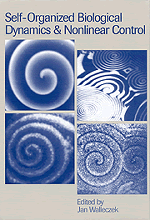 Self-Organized Biological Dynamics and Nonlinear Control
Self-Organized Biological Dynamics and Nonlinear Control Book contents
- Frontmatter
- Contents
- List of contributors
- Preface
- The frontiers and challenges of biodynamics research
- Part I Nonlinear dynamics in biology and response to stimuli
- Part II Nonlinear sensitivity of biological systems to electromagnetic stimuli
- Part III Stochastic noise-induced dynamics and transport in biological systems
- Part IV Nonlinear control of biological and other excitable systems
- Index
Part IV - Nonlinear control of biological and other excitable systems
Published online by Cambridge University Press: 14 August 2009
- Frontmatter
- Contents
- List of contributors
- Preface
- The frontiers and challenges of biodynamics research
- Part I Nonlinear dynamics in biology and response to stimuli
- Part II Nonlinear sensitivity of biological systems to electromagnetic stimuli
- Part III Stochastic noise-induced dynamics and transport in biological systems
- Part IV Nonlinear control of biological and other excitable systems
- Index
Summary
One of the most intriguing practical applications derived from nonlinear dynamics has been the development of nonlinear control techniques. The chapters in Part IV explain how they can be employed in the control of chemical dynamics and biological activity. Chapter 14 by Kenneth Showalter outlines the origins of the concept of chaos control and its applications in the control of chemical chaos. As a model system he describes the well-established nonlinear chemical oscillator, the Belousov–Zhabotinsky reaction. The chapter concludes with a discussion of prospects for controlling spatiotemporal chaos. In Chapter 15, William Ditto and Mark Spano present experiments on biological chaos and clinical applications that employ chaos control techniques, for example in the treatment of heart arrhythmias by feedback-controlled electrical stimulation. Finally, they review experiments demonstrating that electric fields can be used in the nonlinear control of neuronal activity. John Milton, in Chapter 16, discusses epilepsy as a dynamical disease within the framework of developing dynamical therapies.
- Type
- Chapter
- Information
- Self-Organized Biological Dynamics and Nonlinear ControlToward Understanding Complexity, Chaos and Emergent Function in Living Systems, pp. 327Publisher: Cambridge University PressPrint publication year: 2000
